

Welcome to Tentzeco, the bustling world of Somatei !
Grab a drink and come explore the vast network of caves they live in, hear the buzzing sounds of workers, vehicles and city life echoing against the walls of the immense caverns they call home.Somatei are a semi-open species by SpaceLorenz, please do not make your own if you don't have a MYO slot. If you want one, join the community!
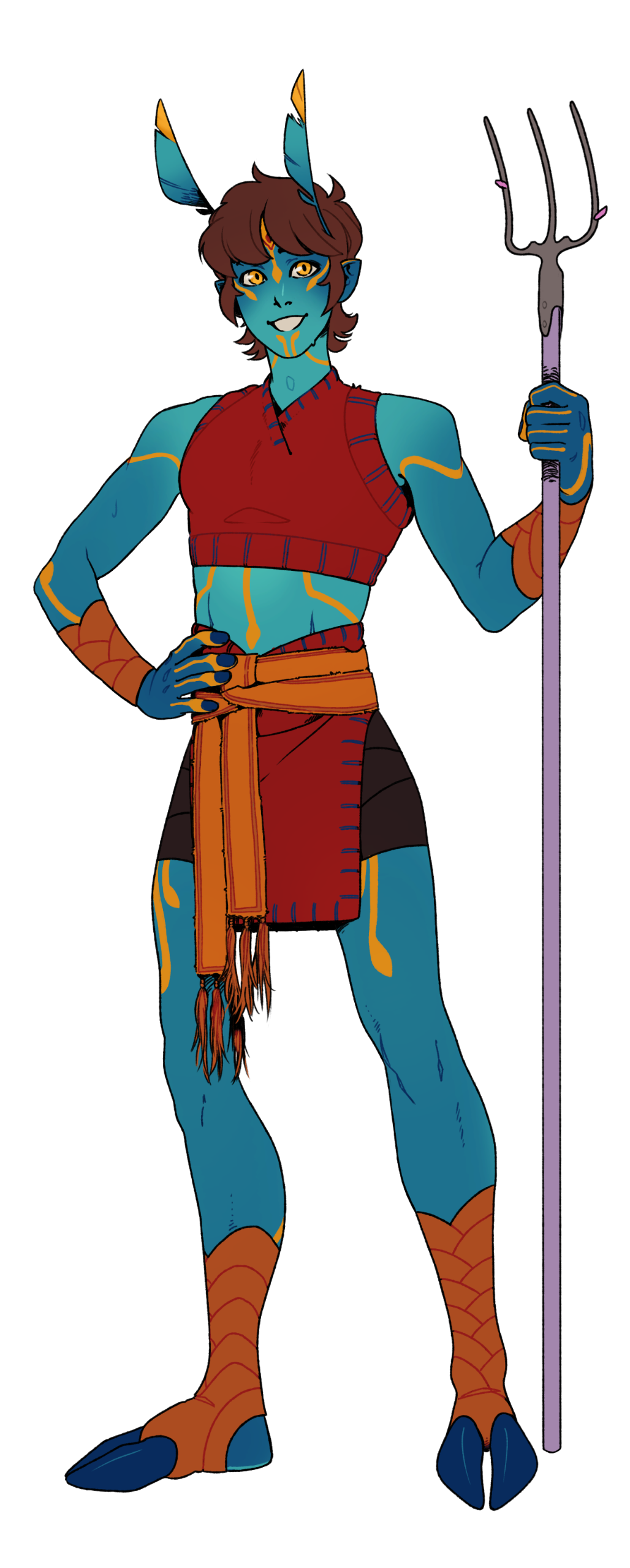
Adopts available!
These two designs are currently available for 200 CHF each! Join the discord server or DM SpaceLorenz if you're interested in them :)
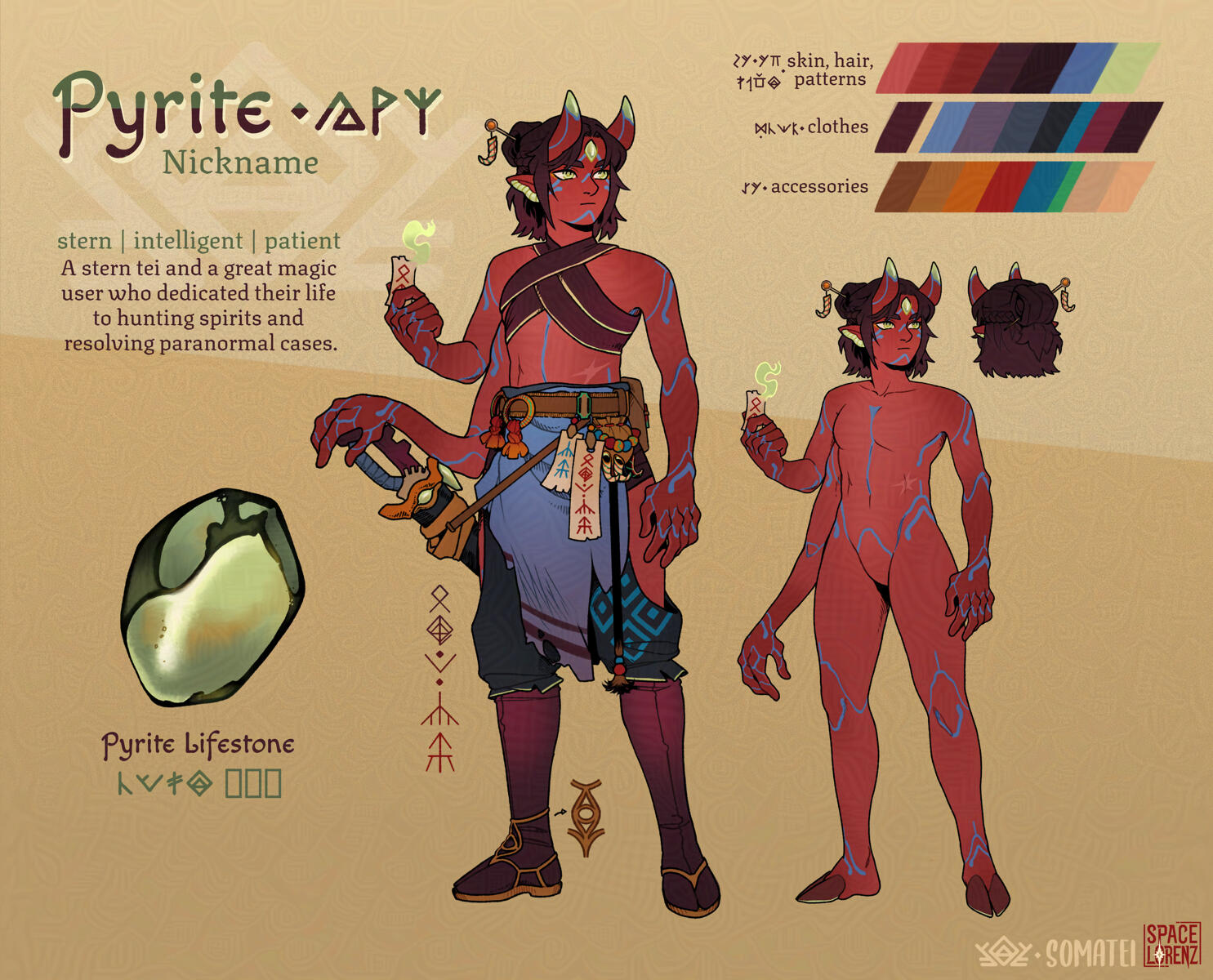
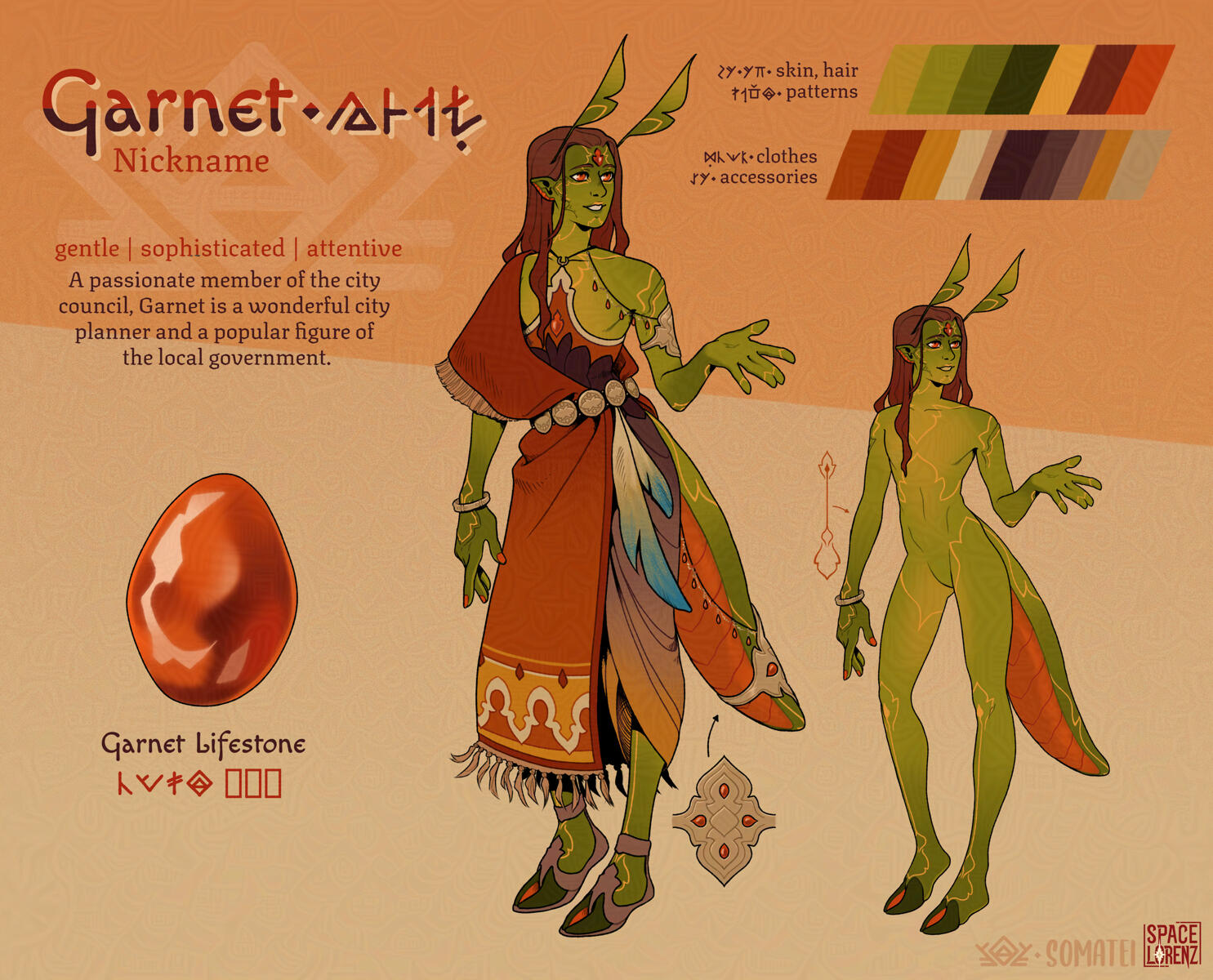
What's all this ?
Somatei are a participative worldbuilding project. SpaceLorenz created and is expanding on this species of humanoid critters and the world they live in, with their civilization, biomes, beliefs and technologies.The project is now open for people to explore and participate in by creating Somatei characters or any work of art they wish to add to their world. The project is meant to be a colorful place where you can escape reality for a bit, debating over lore or making art of your favourite tei.Participating to the species is done mostly through the discord server (link in site header). There you will find all Somatei-related resources and other people who are interested in the project. We're always happy to see new members!This website contains lots of Somatei lore, participation rules and a guide to create your own character. Go back to the homepage to see the different sections :)
I want a Somatei!
That's awesome! There are quite a few steps to follow to get one, so grab a drink and follow this guide.
1. Read the ToS
By acquiring a Somatei, you automatically agree to follow the species' Terms of Service. Failing to follow these terms can get you banned from the species, so make sure you understand and agree with them first.
2. Be on the lookout!
There are multiple ways to get a Somatei:
MYOs
Customs
Adopts
Rehomes
Trading/Gifts
MYO slots will be available for the species' launch - their availability might change depending on the project's development. If you get a MYO slot, you may not commission someone else to create your character, you must do it yourself.
You can trade/gift your MYO slot with someone else, but you must notify Lorenz for the slot to remain valid.Customs can be ordered from SpaceLorenz whenever custom slots are available. Adopt and rehoming auctions will be held on the discord server (link in the site header and footer). They will be announced on social media as well, but I'd recommend joining the server and picking the appropriate role to get pings when auctions open.
3. I want a MYO
MYO slots are given out on the discord server, so you must join it if you want one.
As stated above, they can be traded, and if you want to use yours, you must create the character yourself.
For character creation itself, follow the traits guide (link below) ! MYO characters must be approved before they're added to the masterlist to make sure characters are balanced and lore accurate.The rules are explained in more detail in the section MYO (Character Creation) Rules of the Rules.
4. I want a custom
To pass an order for a custom, you will need at least a general idea for your character. It can be a fully fleshed out concept or just a general theme.
To see what's possible, follow the traits guide linked below and have a look at the making a Somatei section.
Once you got your idea, join the server to see if slots are available. If you don't want to join the server, you can contact SpaceLorenz on any active platform instead.
5. I'd rather get an adopt (or rehome)
Then join the server and get the adopt ping role - you won't be able to participate in the auctions if you don't join. You can always interact with the community while waiting!
6. I want to trade one
In that case, the details are between you and whoever you trade with. Once the trade is complete, you and the former owner both must notify SpaceLorenz and confirm the transaction. The masterlist will then be updated. For details on trading rules, refer to the Reselling section of the ToS.
Species, Rules and Terms of Service
What's a semi-open/closed species ?
In case you're unfamiliar, a "species" in the context is a fictional species created by an artist. Making and adopting characters is controlled by said artist and characters are often custom-made. Owning a character from such a species gives access to interactions and collaborations within its community.
A species is closed when only the species owner (and maybe some mandated artists) can create new characters. It is semi-open when people can occasionally create characters, usually using MYO (Make Your Own) slots. It is open when anyone can create a character whenever they want.
What is a MYO slot ?
MYO stands for "Make Your Own", it's like a ticket that gives you permission to create a character and it's a common
way for semi-open species to function.
Somatei are currently semi-open. You can order customs, trade characters or get a MYO.
General
The following rules are subject to change and will be adapted with the species' evolution. They are written assuming members will use common sense but might have to be tightened if needed.Somatei are a species owned by SpaceLorenz. You cannot create a Somatei without SpaceLorenz' explicit permission (a MYO counts as explicit permission ;) ). You need to be at least 18 to own one and to join the related discord server.Work related to the Somatei species, be it artwork, text or other content cannot be used in any context using AI image generation or NFTs. You can sell Somatei-related work you made (for example prints of your character etc.) , and offering commissions in the context of the species is encouraged!Do not harass members to get gifts or to buy/trade their character. Any cases of theft, scams or similar situations will be sanctioned. Such cases must be reported to SpaceLorenz as soon as possible.Failure to adhere to the rules will result in an immediate blacklisting from the species. By acquiring a Somatei, you automatically agree to the rules.
Adoption
You can currently acquire a Somatei by the following ways:
Customs made by SpaceLorenz
MYO tickets
Adopts for sale (original designs or rehoming)
Trading
Customs
You can contact Lorenz at any time to see if custom slots are available. Note that SpaceLorenz' usual Terms of Service apply to custom design commissions. (You will be given a link to said ToS if you order a custom.)Adopts
Auctions for adopts will be available on the official discord. When adopting a Somatei, you can decide on their name and lore.Lore and AUs
While there is an official version of the lore, you can create AUs (Alternate Universes) as you wish. Your Somatei can be an AU version of another OC, but if that OC is from a closed species, you will need the owner's explicit approval.
If you transfer ownership of your Somatei to someone else, you must agree with them on who gets the non-Somatei AU versions or void them.
You can create minor characters to fill up your Somatei's life, but they cannot be used as species members without explicit approval (that means ordering them as customs or using a MYO ticket for them).
MYO (Character Creation) Rules
MYO Tickets
MYO slots for Somatei are called MYO tickets. Only SpaceLorenz can create new MYO tickets. You must have one if you want to create a Somatei yourself and have them be added to the masterlist (the official list of approved characters).Once the character is approved, the MYO ticket is voided. Active MYO tickets can be traded freely, but SpaceLorenz must be updated on who currently owns said ticket.
If you have a MYO ticket, you must create the character yourself, you cannot commission it.
Character Creation and Approval
To create a character, you must first get a MYO ticket. Tickets will be distributed depending on the species' activity, you can get one via the discord server or DM SpaceLorenz for one.Once you have your ticket, you must follow the character creation guide on this site to conceptualize our character. Feel free to share your process on the discord server! SpaceLorenz will be happy to help you during the process as well :)Once your character is ready, it must be submitted to SpaceLorenz to be approved. You must have completed the character creation guide and your character must have all necessary traits picked, a lifestone, a name, a nickname, a special interest and a reference image.Before the character is approved, SpaceLorenz will make sure the concept is fair to other members and works with the overall worldbuilding.Your approved character will be posted in the discord server in #somatei-census, and this will give you access to using it within the community. Getting a character approved will consume your MYO ticket.
Voiding
When voided, a design will be removed from the masterlist and erased from the lore.
Somatei can be voided by their owner's decision, or if their owner is banned due to breaking the rules.
Designs from banned users will not be reused, other voided designs can be unvoided by their owner.
Reselling
If you wish to part with a Somatei design, you can make your own agreement to resell, trade or gift your design if you want someone in particular to have it.Reselling in an auction can be done on the official discord only. Contact SpaceLorenz and he will setup a (flat sale) auction on the discord server for you.
Designs can only be resold at the same price they were first bought, plus a reasonable amount if the character has additional commissioned artwork. Designs created using a MYO slot can be resold as well, the price will be determined based on the reference sheet quality (time spent on it, amount of details etc.)
If the design was gifted to you, you cannot resell it (you can only trade it).You can trade or gift designs within or outside of the species server.Wether reselling, trading or gifting, ownership will be updated on the masterlist once the former owner and new owner of the character have confirmed the transaction.
The new owner must join the server or give SpaceLorenz a way to contact them.
Other Contributions
You can create other types of contributions to the Somatei species and universe such as stories, new biomes, new animal and plant species, roleplaying rules systems, etc. You don't need a MYO slot or any particular permission to start.All these contributions must be linked to the species by excplicitely stating they are made in its context and by linking to this website or SpaceLorenz' socials when posted about. Same as MYOs, they must be approved by Spacelorenz to be made official.And as always, feel free to discuss and post wips in the server!
Species Overview
Somatei are a peculiar species: two legs, two to four arms, a pretty pair of antennae, an insatiable thirst for discovery and a body covered with markings that guide the life flowing from the stone set on their skull to the tip of their fingers.
As described below, Somatei do not reproduce by conventional means. They have no sexual characteristics and no concept of genders.
They can be found deep within Tzeco; exploring the vast network of caves they live in, you might hear the buzzing sounds of workers, vehicles and city life echoing against the walls of the immense caverns they call home. Streets, houses and workshops are dotted with colorful lights, filters over flames or scraps of bioluminescent life, shining against the inhabitants’ colorful outfits. The walls are covered with patterns and paintings depicting their life with varying amounts of creative liberty. Outside though, it’s pitch black and only the bravest dare venture where no tei has layed foot before.
The Caverns
Somatei live in caverns deep underground. In fact, they don't even know if anything else exists other than walls of rock and endless obscurity.Outside of civilization, life tends to thrive in self sufficient, very distinct biomes. Large caverns, especially if lakes are present, can foster complex ecosystems. In Tzeco, a lot of species are bioluminescent and some plants even communicate using light signals, which Somatei take advantage of a lot.
Society
Somatei live in communities of various sizes, with a few cities gathering over 20'000 inhabitants. Everyone has a spark for discovery, would be through innovation, exploration, the thrill of discovering a new monster or trying new tastes in their kitchen.
Biology and life cycle
The soxai, or lifestone, is belived to hold a tei's soul. Remove the stone, the body lays lifeless. Toss the stone in a bed of soma (or life-moss) and a new tei will emerge after some time.Somatei emerge from soma beds a bit shorter and weaker than adults. They are then adopted by a small community, couples, friends or polycules living together and spend 5 to 7 years learning about the world.Somatei can live for about 80 years before old age gets the better of them. On one's death, their lifestone is put back into a soma bed so that a new body can form. The new somatei will keep some tendencies from their previous life but will lose all their memory.As for the soma itself, Somatei do not yet understand how moss chambers and moss beds really work, though they know they are packed with magic. Life energy runs along ancient carvings filled with gently glowing, hanging curtains of green moss and the soil is covered in a layer so thick noone knows where the bottom is.
Tzeco's World
While ideas of “the surface” or “the sky” might be familiar to readers, they are not for Somatei. Their world is a largely uncharted system of caves, cliffs and narrows, often deadly, sometimes so stunning it makes exploring worth the risk.
Somatei are mostly gathered around a few well-lit cities, connected by secured roads sometimes cut through the walls of stone, but most often following natural paths dug by rivers over millenia or vertiginous cracks between layers or rock.
The cities themselves are built on the ground and against the walls of caves. Villages are sprinkled around, always linked to at least one city by a main road.
Flora
Outside of civilization, life tends to thrive in self sufficient, very distinct biomes. Large caverns, especially if lakes are present, can foster complex ecosystems.
In Tzeco, a lot of species are bioluminescent and some plants even communicate using light signals.As for useful species, Somatei like to exploit innoma, or glow-moss, to aliment lamps and street lights. Innoma grow in many different colors, making for pretty lighting through the streets of tei cities. There are also species of taller luminous plants perfect for potted decoration or signage.

Literal and metaphorical pillars of Somatei life, keltza (or shadeshrooms) are a group of tall mushroom-like species. Blue keltza in particular have a thin trunk and a wide, flat cap that glows gently underneath. They are used as a base for building houses, as walls are built under the cap that serves as a roof.
Larger infrastructures can be built around a row of blue keltza and for really big structures, red keltza can be used instead.
Red kestza are especially tall with thick trunks and a few branches but almost no cap. They are often planted against cliffs and used as pillars to construct stairs or elevators. Their sticky red sap has an irritating odor and can cause nasty skin reactions, consequently various techniques have been developed to build around the plant without ever wounding it.
Somatei also grow various crops as well as fruit-bearing plants used for cooking, making fibers, decoration, dye, medicine and many other applications.
Fauna
Numerous species of insects, fish and other small animals can be found when exploring, and many are kept as livestock, beasts of burden or even pets.
Tzolot are a popular pet that thrive in parks and gardens. They tend to pick a favourite tei they will follow around and greet with little squeaks of joy. Sauatzal (sa-wa-tzal) are also popular but rarely used as pets due to their size, but also the great deal of attention and extensive training they require. Though once bonded with their tei of choice, they make great bodyguards and pack animals.In the dark though, many greater monsters roam and danger is never far away. Somatei have a well organized militia that guard the outskirts of cities and patrol the roads, keeping everyone safe - most of the time. The most combat-thirsty tei specialize in monster handling, spending their time learning beasts’ patterns and predicting their behaviour to evacuate areas in time before an attack. Once everyone’s out, they can focus on the battle.
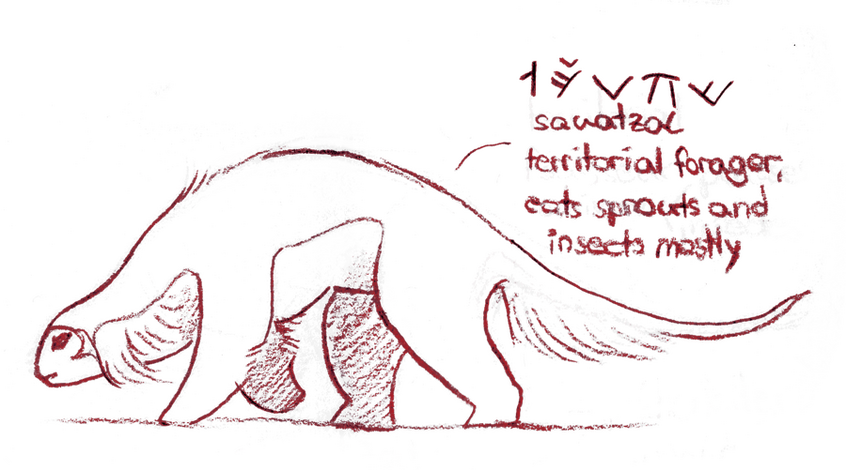
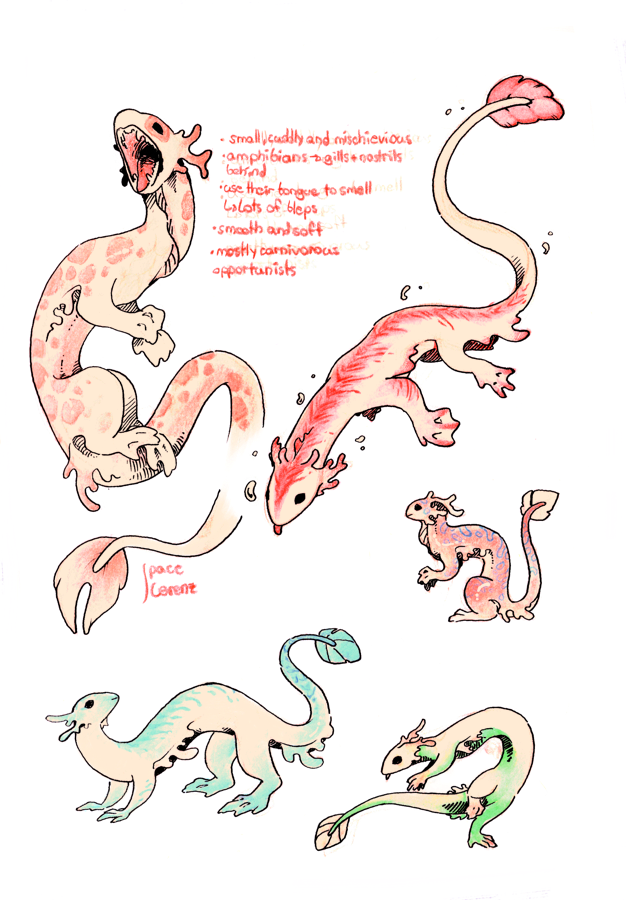
Society
Outside of Tzeco’s various dangers, life in Somatei society is pretty nice. Everyone has a spark for discovery, would be through innovation, exploration, the thrill of discovering a new monster or trying new tastes in their kitchen. Most days are dedicated to work (which usually overlaps an area of interest), hobbies and resting.
Somatei do not use any monetary system; work in general is considered to be for the benefit of society, and society gives in return. That said, bartering is often used to trade personal belongings or small services between individuals. It is seen as a healthy practice among young Somatei, as it teaches them fairness and the value of things.
Innovate, Explore, Protect
Society is organized around three main axes: innovation, exploration and protection. Most tei have a thrill for discovery and an instinct to preserve their peers. Some find their happiness in extending the borders of the known world, bringing back strange souvenirs and tales of their adventures.
Others will rather stay in town and let their arms or brain do the work: construction workers, cooks, farmers, scientists. They find joy in the fruit of their labor and in pushing the limits of their people’s knowledge ever further.
Finally, protectors are driven by a sens of duty, willingness to preserve peace or even a taste for battle. Those will patrol the dimly lit roads between towns, watch for wild beasts and will not hesitate to draw their weapon if needed.
Technology
Somatei technology works, well, most of the time. Living plants are often used for building big infrastructures - for example red kestza for stairs and elevators. The Somatei know how to use steam from natural hot springs, running water and elaborate counterweight systems to power their most impressive amenities.
Life cycle and Biology
Lifestones
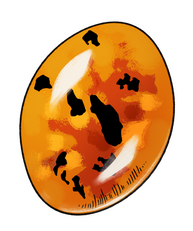
"Do you think sometimes, about the fact we’re basically a stone piloting a flesh suit?”The soxai, or lifestone, is the core of a Somatei’s life. Remove the stone, the body lays lifeless. Toss the stone in a bed of soma, or life-moss, and a new tei will emerge after some time.A lifestone is believed to hold a tei’s soul. Most are made of precious or semi-precious gems, although other types of mineral and even fossils have been used. Lifestones are roughly the size and shape of an eye and lay on a tei’s forehead, protected by a pair of lids.
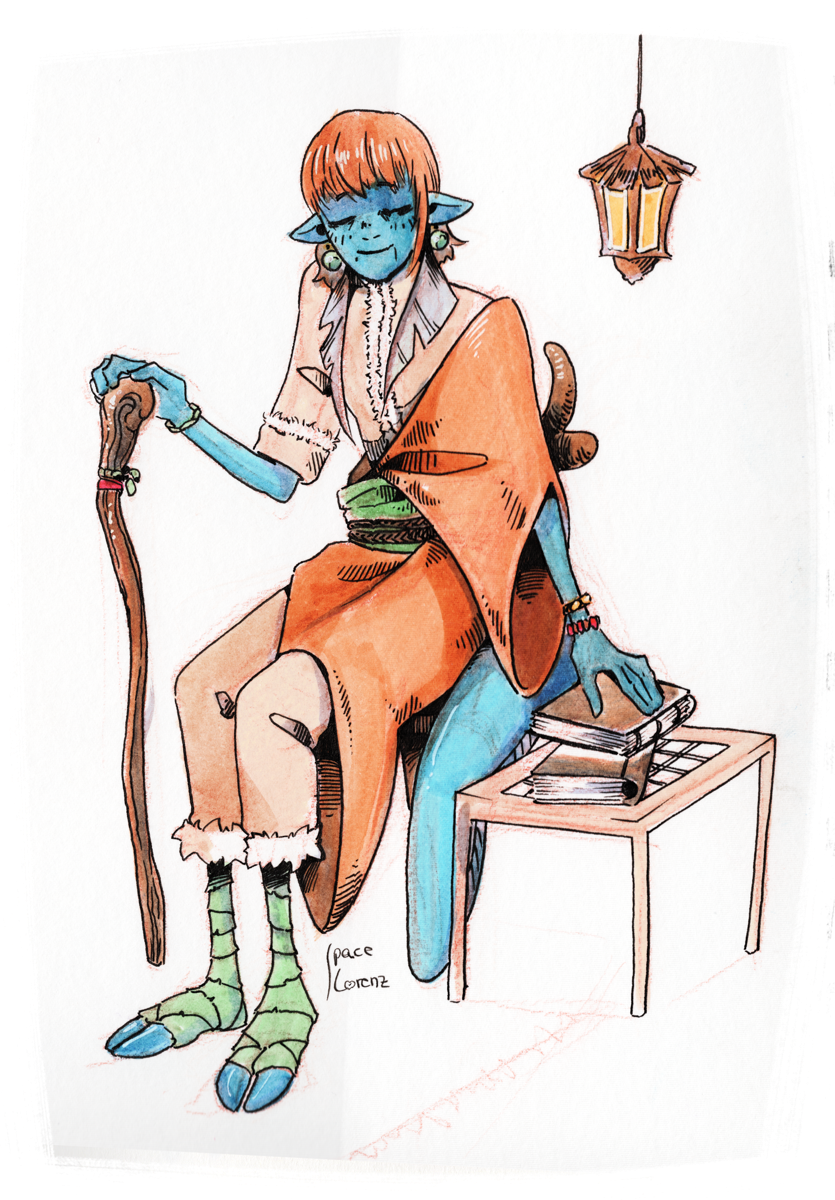
Somatei naturally age and when their body aches more than it brings joy, it is laid to rest under a moss chamber while their lifestone is extracted and brought back to the moss to grow a body anew. Most existing stones have lived many lives before, and while Somatei do grieve the end of a life, the loss or destruction of a lifestone is a devastating event that will send a whole city into despair. Thankfully such events are very rare and many steps are taken to make sure every stone is safe.
Although they can’t recreate the body growing process, skillful jewelers are able to make new lifestones. A new stone’s first life is always a bit clumsy, but its soul strengthens with every cycle.When a new Somatei emerges from the moss, all memories of their previous life are lost, though their appearance and interests tend to turn out similar to what they were before. Young tei are born a bit shorter than adults, able to crawl and feed themselves, but they yet need to grow strong and learn taletei and the workings of society. Newborn Somatei are taken in by couples or small groups of close friends that pledge to take care of them until they can live on their own. Young tei spend most of their time in school learning the inner workings of Tentzeco and dipping their hands in every subject so they can find their spark.
the Moss Chambers
Somatei do not yet understand how moss chambers and moss beds really work, though they know they are packed with magic. Life energy runs along ancient carvings filled with gently glowing, hanging curtains of green moss and the soil is covered in a layer so thick noone knows where the bottom is.
Moss chambers are heavily guarded and carefully tended to as they are the only means for new tei to be born. Attempts have been made to grow new beds, copying the original carvings, carefully picking the type of mineral the new chamber is made of and grafting pieces of life-moss on the walls, all in vain. Though failure hasn’t stopped any tei from trying again yet.
One successful invention though was the tzautan. Tzautan are tiny creatures with a lifestone instead of a heart, grown from successful, small scale grafts of life moss on a variety of kestza. A tautan grown around a tei’s lifestone that has not been plunged into a moss bed since their death retains their memories and can still talk and write to some extent. The resulting creature however will easily get sick or even suffer from necrosis, as if the stone can’t keep it together for long.
If the stone has been laid in a moss bed after a tei’s death though, the resulting tautan will have limited memories and intelligence, depending on the amount of time the stone remained in moss, but it will be energetic and will maintain their health easily.Tzautan are mostly created in two types of situations: when a deceased Somatei held precious information, a tzautan can be grown around their lifestone to retrieve said information. The other use is to protect the stone, usually while the local moss chamber is full. Even the most animalistic of tzautan remain pretty smart, making for a great protector. If kept for a while, such tzautan tend to gain Somatei-like intelligence, and some even start to learn reading and talking.
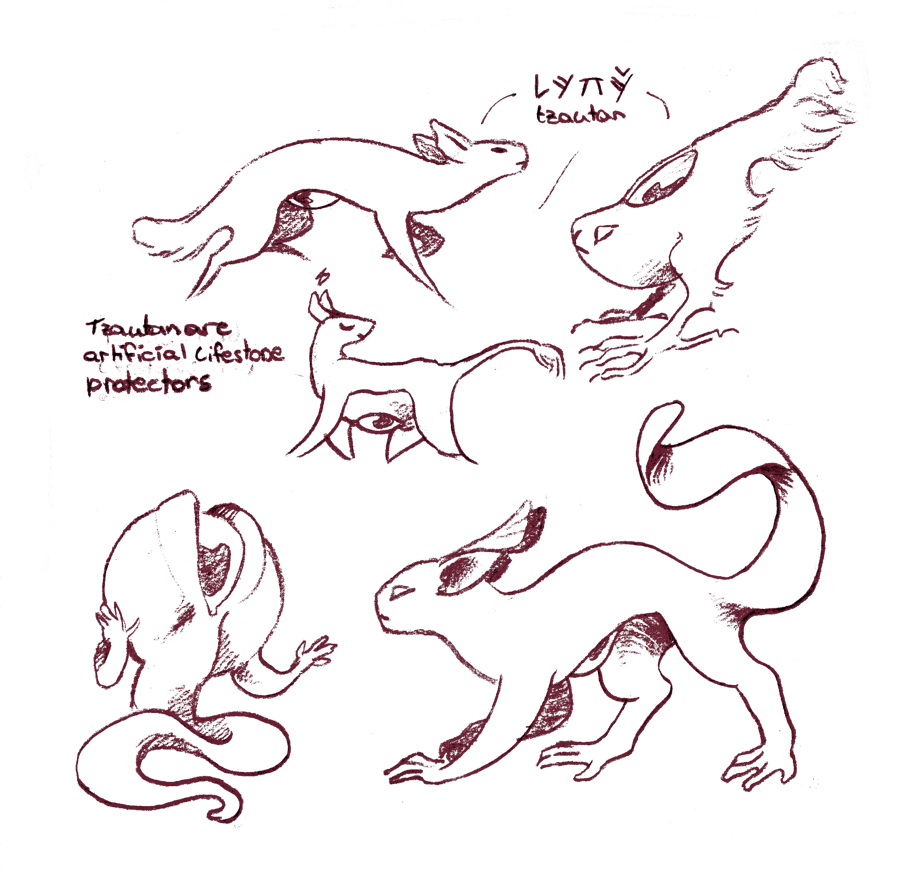
After their duty is done, most memory-retaining tzautan wish to be put to rest, so their body is put back into the moss bed cycle when it crumbles away and a new Somatei grows around their lifestone.
When a spot is free, tzautan that have lost memory are also put back into the chamber. This time the tei body is believed to grow around the tzautan since resulting Somatei retains memories from their life as a tzautan.Rarely, tzautan express a wish to remain in their current state, content with being a little creature for now. In that case, they are usually kept around and some contribute to society as they can, even though some Somatei see this practice as lazy and self-centered.
Traits Guide
This section is primarily made for members who want to use their MYO ticket, but it also offers details about Somatei anatomy, and customs will be balanced based on this guide as well. So if you're curious about specifics or want a custom, you will find details here.
General information
Somatei are humanoids with a wide range of different morphologies, they can have different number of limbs and varying appendages.
Their skin can be any color and they’re all covered in patterns that have a distinct “style”. The patterns wrap around their whole body and form an indent in their skin.All Somatei have a gemstone (or other hard, precious material such as amber or a fossil) embedded in their skull, in the middle of their forehead. The stone is approximately the shape and size of an eye and has an eyelid. This gemstone is called lifestone and is believed to contain their soul. A Somatei cannot survive without one.
Lifestones are the source of a Somatei’s energy and the patterns on their skin help guide it through their limbs.
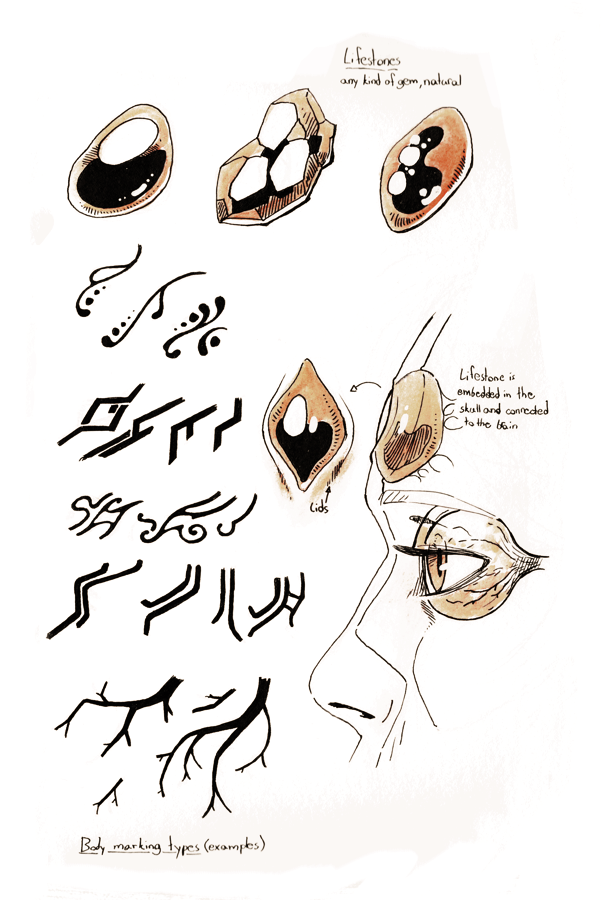
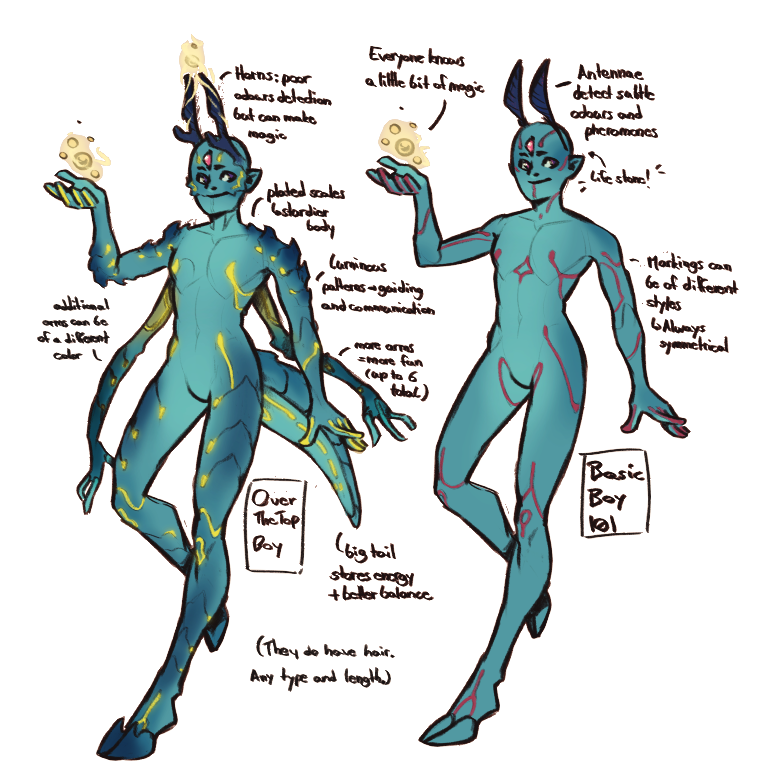
Traits
Traits are organized by category and classified by rarity. Rarity levels are:
common
uncommon
rare
legendary
Colors
Generally, a Somatei will have 4 main colors: skin, hair, patterns and the fourth shade for eyes, lifestone and flesh. Patterns are often the same colour as lifestone. Skin will usually show a soft, lighter gradient on the chest. Hair can be dyed so it can be any color.Note: the following traits are not mutually exclusive.
Default palette (common): as described above, might show variations based on their lifestone's appearance
Multicolored skin (rare): vitiligo or markings can appear naturally
Multicolored patterns (rare): possible if the lifestone has multiple colors (fluorite for example)
Reflective patterns (rare): patterns can be smooth and shiny like metal
Glowing patterns (rare): some tei have magic energy naturally leaking from their patterns. This produces light that can be useful to spot friends in dark environments.
Transplant (legendary): limbs, eyes, skin or other body parts can be transplanted on a tei if the markings can be aligned. The transplanted part (including markings) will keep the coloration and other properties of the original host. Transplants cannot be used to add limbs to a tei.
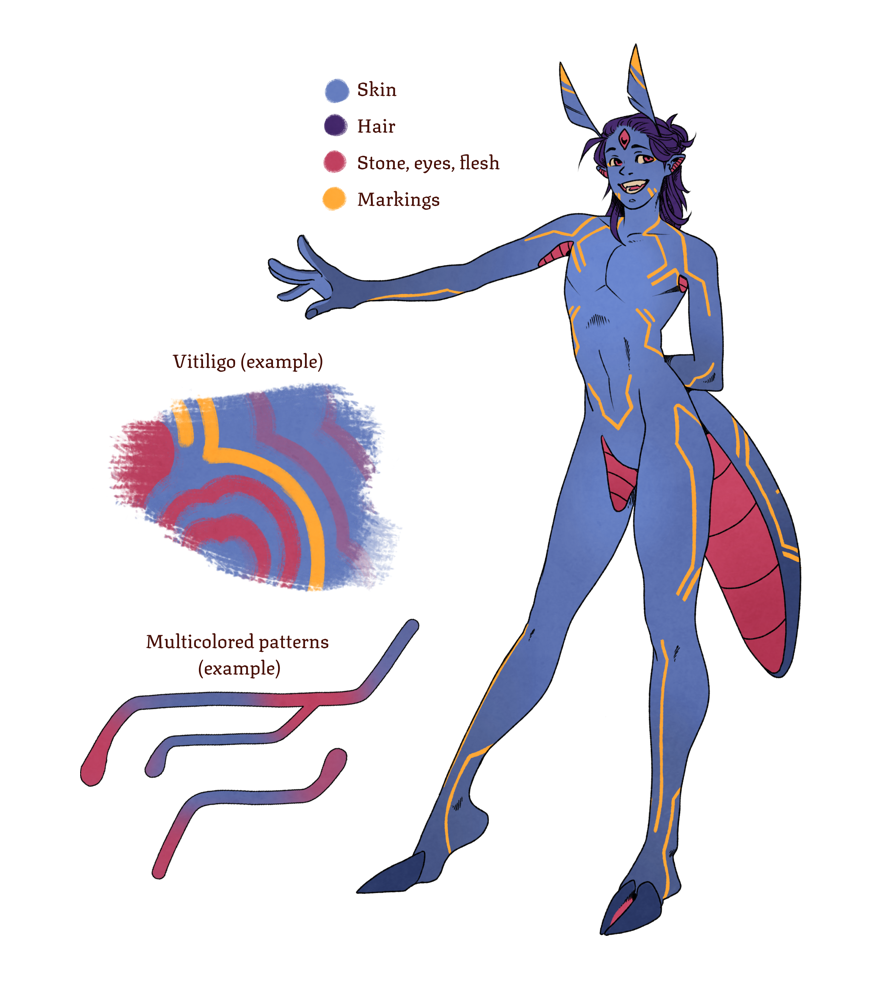
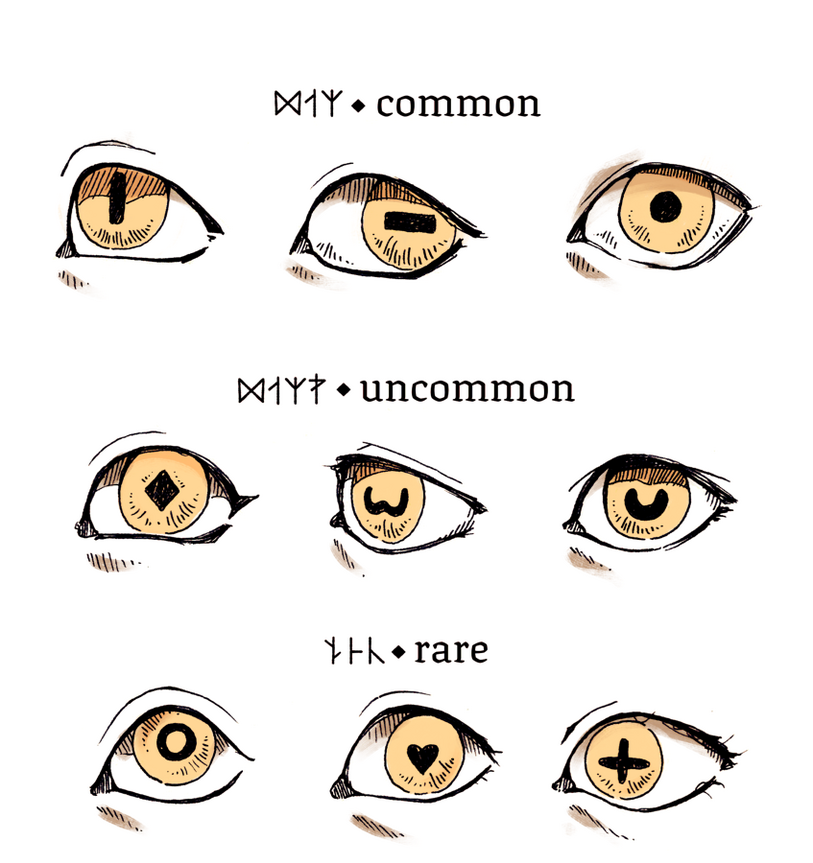
Eyes
Eyes are usually the same color as the lifestone, though this can vary. Pupils can have many shapes, adapted for different specializations.
Multicolored eyes (uncommon): heterochromia or another colour than the lifestone. Not mutually exclusive with the other eye traits.
Round, horizontal or vertical pupils (common)
U shaped, W shaped or diamond pupils (uncommon)
Other pupil shapes (rare)
Horns or Antennae
All Somatei have either a pair of horns or a pair of antennae. They can also have a mix of both. Horns and antennae have the same color palette as a tei’s skin, and can display their pattern color as well.
Horns (common): they have the same range of colours and textures as skin. They’re attached to the forehead or to the side of the head. Horned Tei are proficient magic users, as horns tips help magic flow.
Antennae (common): they are attached to the sides of the head above the ears. They have a similar structure to moth antennae and feel like feathers. They also have the same range of color as skin. Antennae are used for echolocation, a very useful skill for anyone venturing outside.
Mixed (uncommon): a hybrid between both, usually thin horns with a feather-like part. They are never as good at magic or echolocation as their full-blown counterparts but offer a kind of compromise.
Natural asymmetry (rare) : horns or antennae can be asymmetric, usually one longer than the other. Asymmetric tei usually adapt well for echolocation, but magic usage can be more difficult. For asymmetry caused by an injury, refer to the afflictions section. Not mutually exclusive with the other antennae/horns traits.
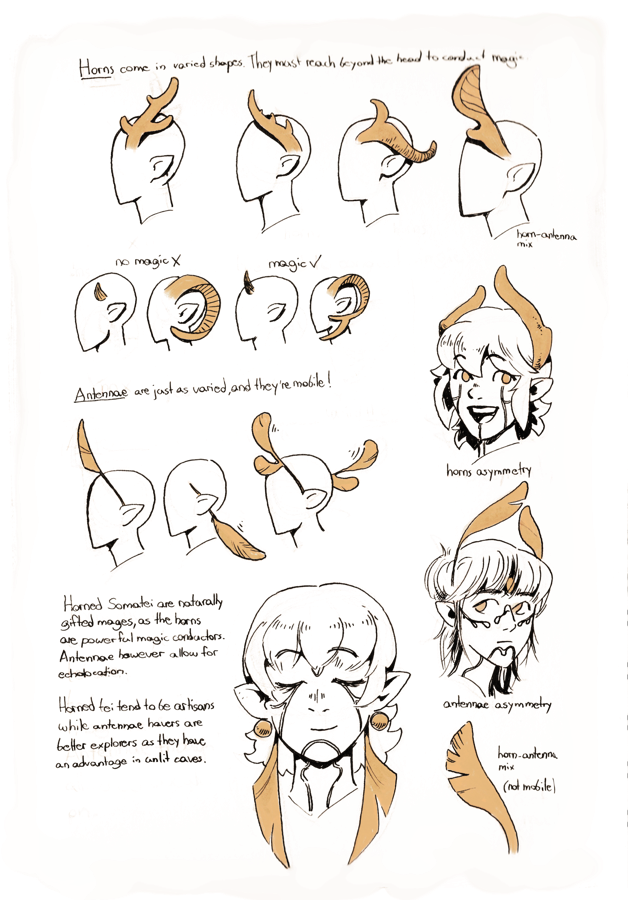
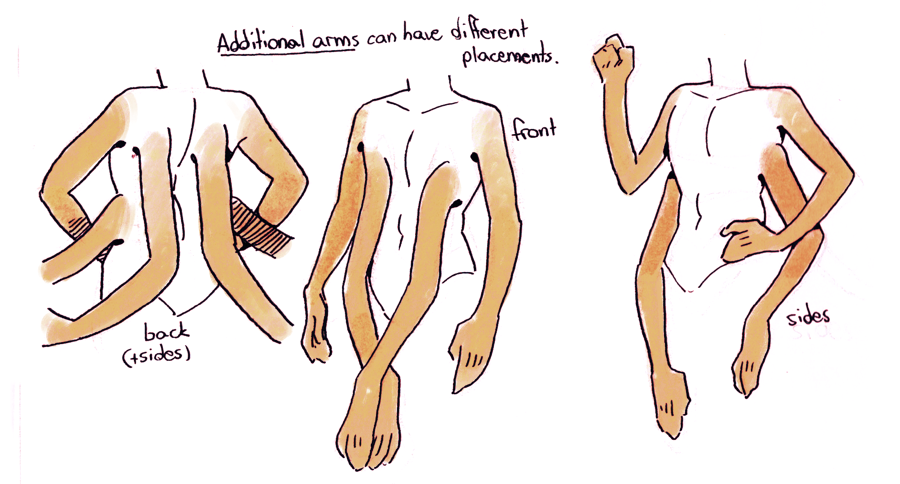
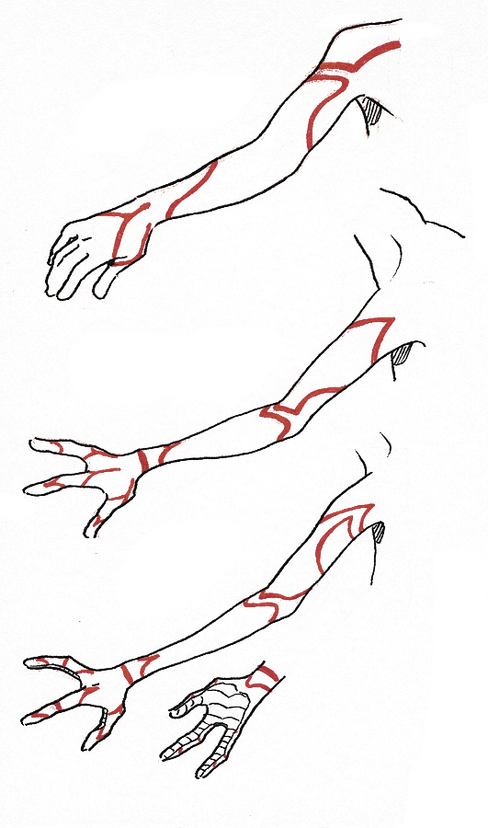
Arms
Somatei have at least two arms, but they can have any number up to 6. Additional arms can be attached to their sides, back, or front of their torso in any combination. Each additional pair is thinner and looks more insect-like; additional arms often have only 3 fingers.
Two arms (common)
3-4 arms (uncommon)
5-6 arms (legendary)
Gaster
All Somatei have at least a tiny squishy tail, but some have a full blown gaster instead. Gasters are energy reserves that inflate and deflate as their content is refilled or used. They attach to the body on the lower back (similar to a tail). A tei can lift or swing their gaster in a limited manner.
No gaster (common)
Small gaster (common): roughly the length of a tei’s thigh
Big gaster (uncommon): longer than a tei’s thigh
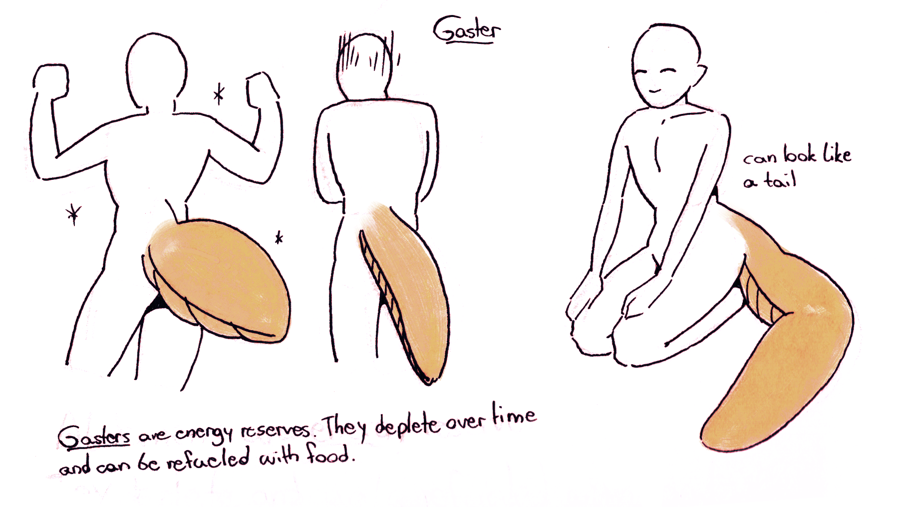
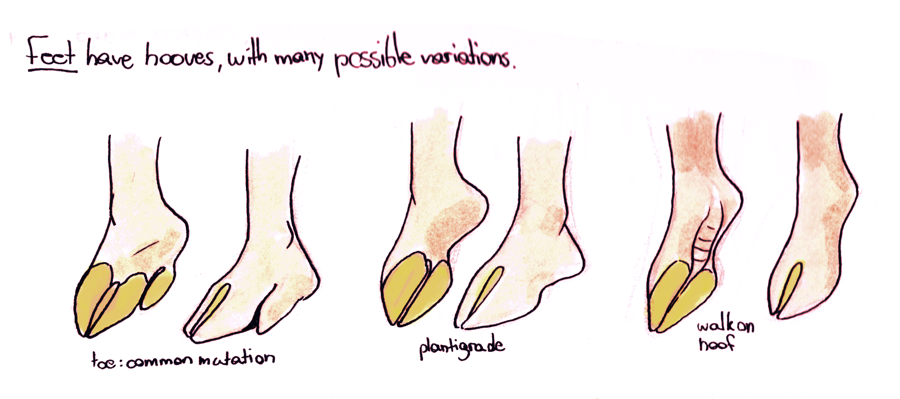
Feet
Somatei are plantigrades but have split hooves instead of toes. Few walk on their hooves only thanks to a mutation.
Default feet (common)
Additional thumb (common): a hooved “thumb” on the side of the foot
Unguligrade (uncommon): walk on their hooves only
Scales
Some tei have hard, chitinous scales that make them sturdier.
No scales (common)
Defensive scales (uncommon): chitin plaques on various places
Offensive scales (rare): protruding, even spiky chitin growths
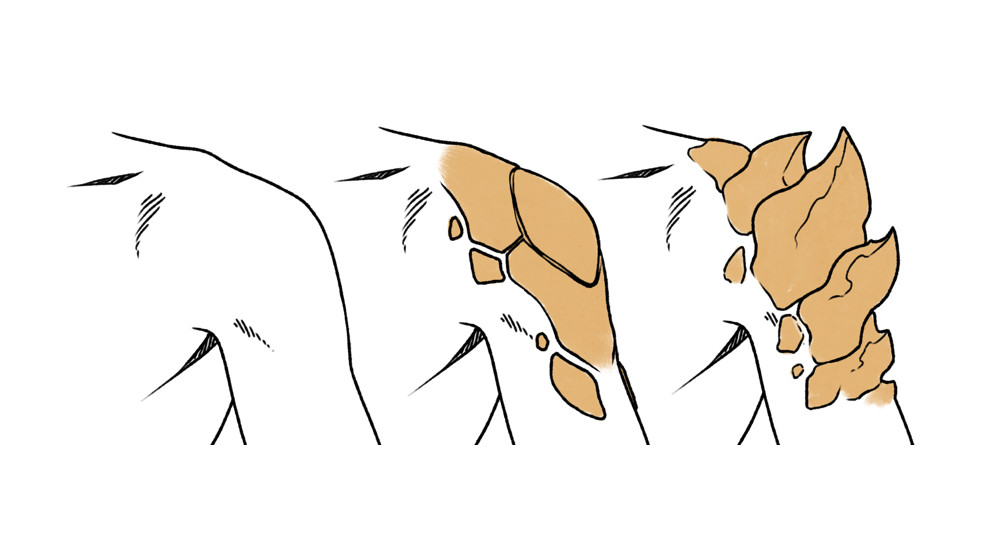

Afflictions
A lot can happen during a tei's life, and some events do leave marks.
Afflictions here refer to any kinds of wounds, disabilities or chronic diseases, whether from birth or acquired.
Minor affliction (common): one-eyed, small scars, wound or malformation
Major affliction (uncommon): blindness, excessive scars, other disabilities
Making a Somatei
To make a somatei, you can start by picking a lifestone material. It can be any precious or semi-precious stone, or adjacent materials such as amber of fossils, wether real or fictional.
Then, they need at least one special interest, what drives them and will shape their life.
Finally, you can pick traits out of the list. You get 11 points that you can spend to make whatever traits combo you’d like, knowing they have a cost depending on their rarity (you don't have to spend them all) :
| Rarity | Cost |
|---|---|
| common | 0 |
| uncommon | 1 |
| rare | 3 |
| legendary | 9 |
Traits Summary
Independent traits (not mutually exclusive with any other)
Multicolored eyes (uncommon)
Multicolored patterns (rare)
Reflective patterns (rare)
Glowing patterns (rare)
Horn/antennae asymmetry (rare)
Transplant (legendary)
Skin
Default palette (common)
Multicolored skin (rare)
Pupils
Round, horizontal or vertical pupils (common)
U shaped, W shaped or diamond pupils (uncommon)
Other pupil shapes (rare)
Horns/Antennae
Horns (common)
Antennae (common)
Mixed (uncommon)
Arms
Two arms (common)
3-4 arms (uncommon)
5-6 arms (legendary)
Gaster
No gaster (common)
Small gaster (common)
Big gaster (uncommon)
Feet
Default feet (common)
Additional thumb (common)
Unguligrade (uncommon)
Scales
No scales (common)
Defensive scales (uncommon)
Offensive scales (rare)
Afflictions
Minor (common)
Major (uncommon)
Species reference sheet
This is a short guide to be used with a character's reference sheet. It aims to clarify important details without having to read the whole traits guide.

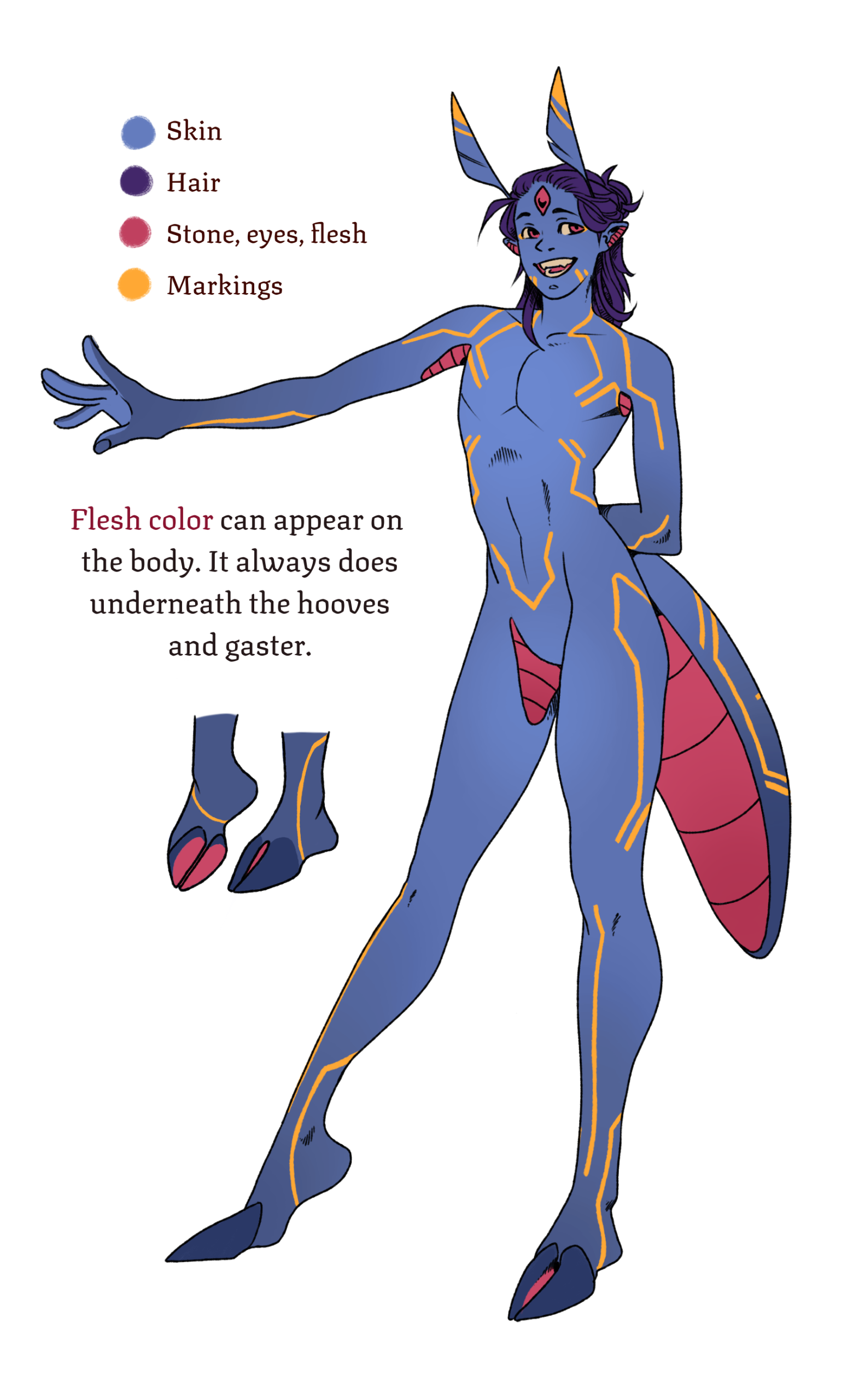
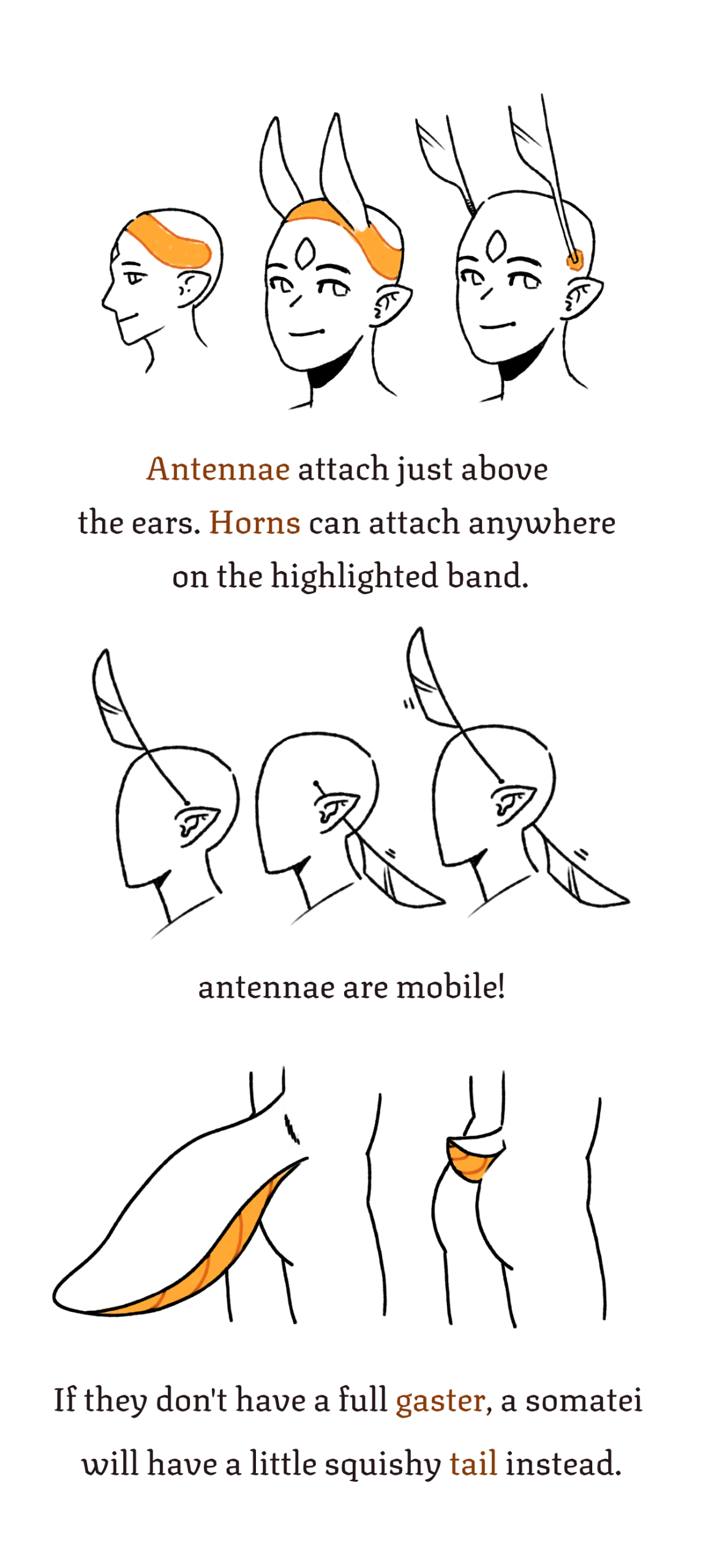
Here's everything in one image if you prefer using it! You can download it and use it with your own character for reference.
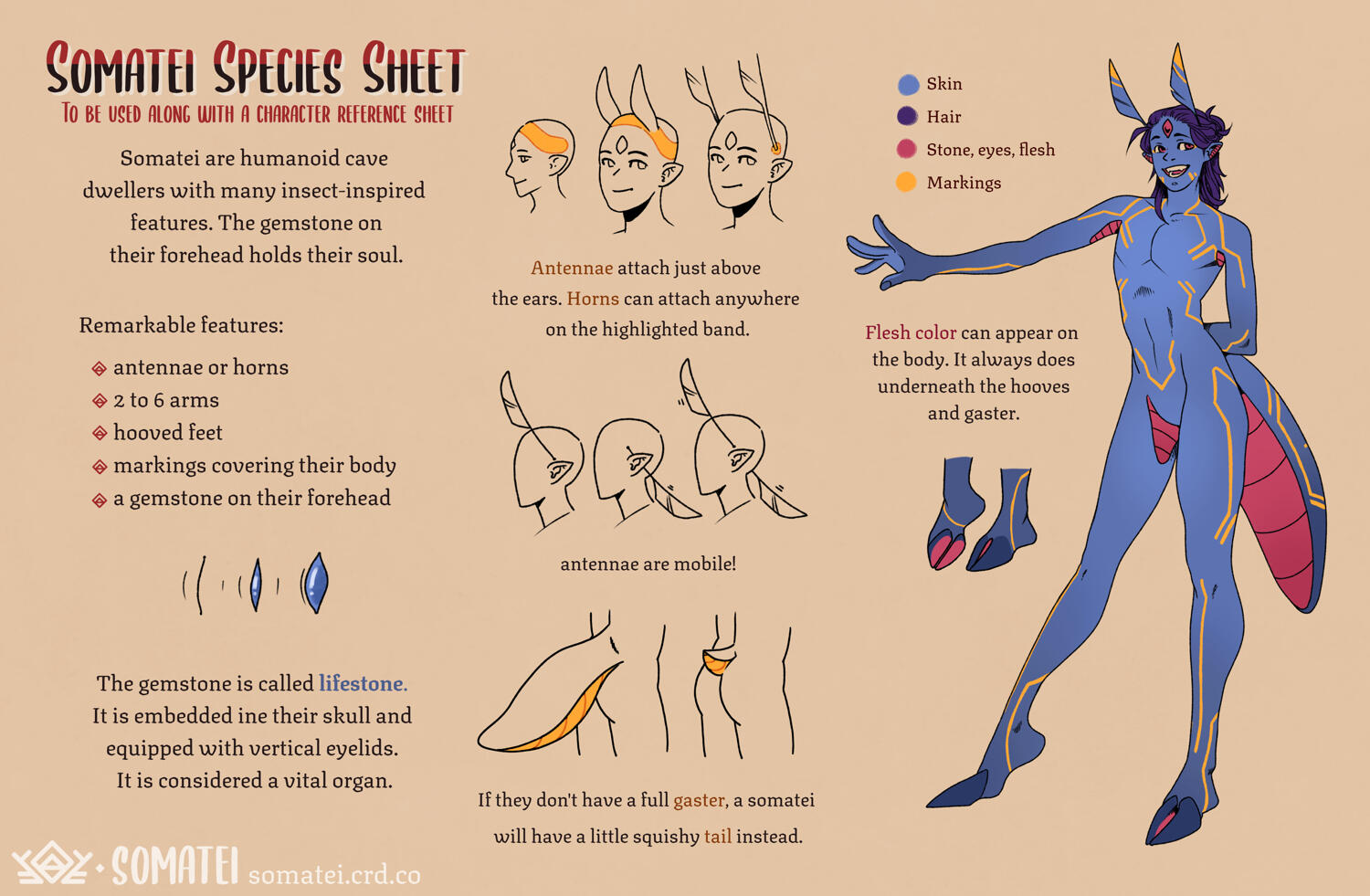
Somatei's language: Taletei
Somatei have their own language ! Consequentially, you will come across a number of words in that language. This page will give you a translation for common words, important concepts and an intro to Taletei.
Glossary
Somatei - a people of cave dwellers with insect-like features, driven by the thrill of discovery
tei - abbreviation for Somatei. It also means “person” in their language
taletei - the Somatei’s language
innoma - glow-moss, designates various species of bioluminescent plants
kestza - shadeshroom, various species of giant, mushroom like plants
red kestza - a huge variety of shadeshroom with a large trunk
blue kestza - a variety of shadeshroom used to build houses
tzolot - a species of small pets that look like axolotls
sauatzal - a species of big, hard to train pets and guardians
tzautan - small artificial creatures with a lifestone in place of a heart
soma - life-moss, the mysterious moss that grows new bodies for deceased Somatei
soxai or teixai - lifestone, the gemstone that holds a tei’s soul
Taletei
Taletei is the one language spoken by all Somatei. It has a limited number of different syllables and is written with a mix of ideograms and a syllabary. Since they commonly carve text in stone, symbols tend to be made of straight lines. Text is typically written right to left, or top to bottom in some cases. Below you will find the common syllabary and diacritics.
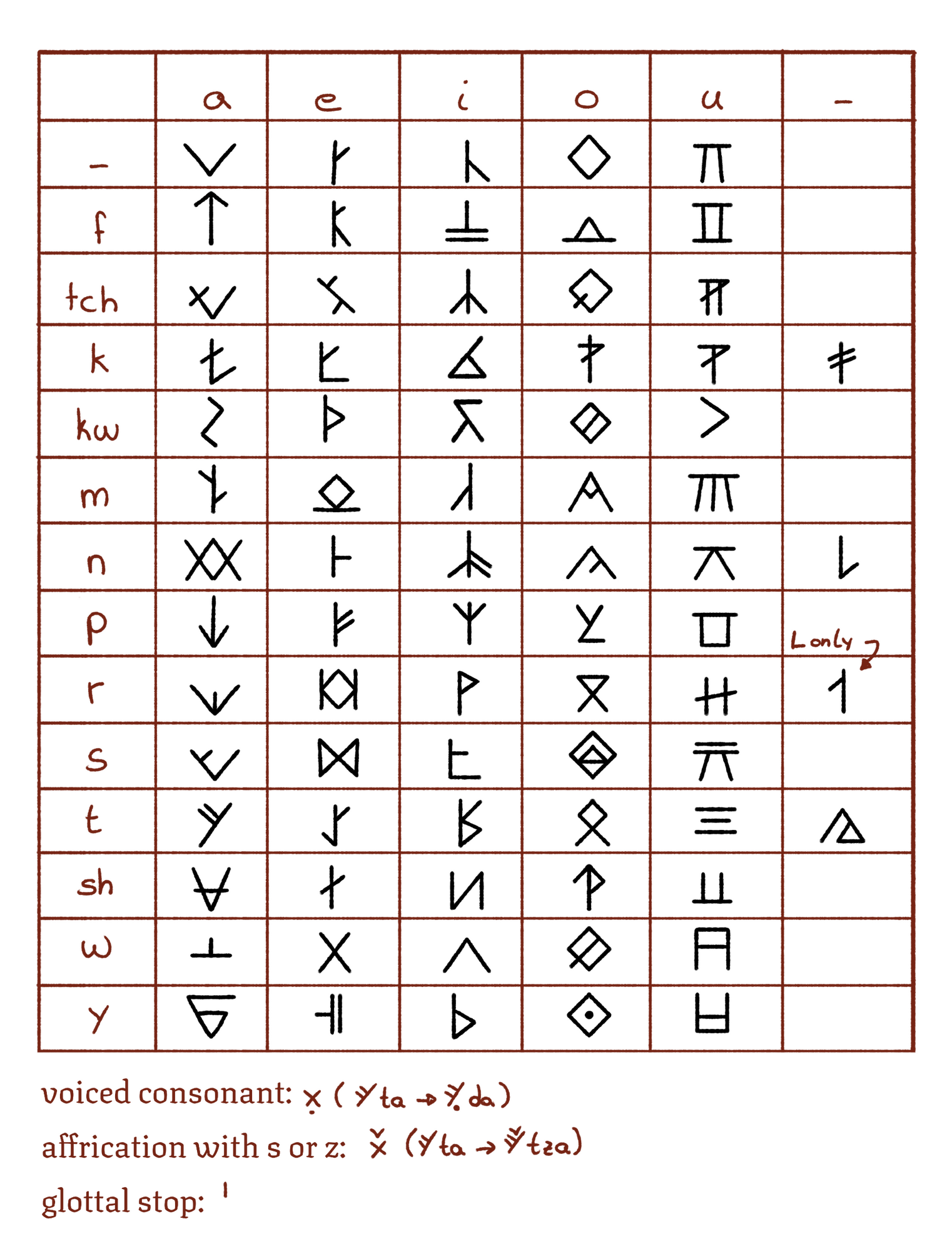
Pronunciation
Pronunciation should be pretty instinctive for english or french speakers, just keep in mind every letter is always pronounced. Below is a phonetic guide for vowels and potentially unclear consonants.
For letters with mutliple phonetic choices (e and o), it means both are used but not distinguished.
| Letter | Phonetic | Example words | Example words FR |
|---|---|---|---|
| a | a | cat | chat |
| e | e, ɛ | day, egg | dé, mettre |
| i | i | happy | lit |
| o | ɔ, o | choice, grow | gros, fort |
| u | u | goose | genou |
| tch | tʃ | cheap | scotch, matcha |
| kw | kw | queen | quoi |
| r | ʁ | just listen to a french r | rester |
| Letter | Phonetic | Example words | Example words FR |
|---|---|---|---|
| sh | ʃ | sheep | chat |
| w | w | wish | oui |
| y | j | youth | yeux |
| tz, | t͡s | cats | tzigane |
| kz | k͡s | axis | axe |
| pz | p͡s | psalm | psy |
| dz | d͡z | pizza | pizza |
| gz | g͡z | exact | Xavier |
| bz | b͡z | clubs | genre un bruit d'abeille |